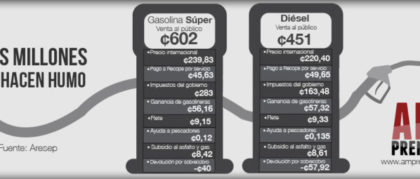
Source: ARESEP
Have you ever wondered what happens with the billions of colones drivers pay for fuel? It is common to think that much of that money is used for payments abroad, but it is not.
According to data from the Regulatory Authority for Public Services (ARESEP), 56% of the value of every liter of gasoline goes for subsidies for private entrepreneurs and payments to Costa Rican Oil Refinery (RECOPE).
For example, in the case of super gasoline, the current international price per liter is ¢ 239.35 colones. However, extra fees must be added, such as the amounts paid to RECOPE for using its facilities, pipelines and to pay salaries and collective benefits for workers. Today, that amounts to 45.63 ¢ per liter.
In addition, 9.33% (¢ 56.16 per liter) and 1.52% (9.15 ¢ per liter) are allocated for gas stations’ revenues and the freight charge to transfer fuel from the campus to gas stations.
There are also government subsidies for fishermen (¢ or 12 cents per liter) and for the owners of construction and industrial companies to lower the price of asphalt and gas (8.42 ¢ per liter) must be added as well.
However, the highest category is the fuel tax, for which Costa Ricans pay ¢ 283 per liter. Most of this amount goes for the payment of wages, the State’s Fund, CONAVI, the MAG, the Red Cross and municipalities.
Lastly, the formula shows a decrease of ¢ 6 around, since RECOPE overcharged fuels for several months.